

Compact Muon Solenoid
LHC, CERN
| CMS-PAS-LUM-21-001 | ||
| Luminosity determination using Z boson production at the CMS experiment | ||
| CMS Collaboration | ||
| 20 March 2023 | ||
| Abstract: The measurement of Z boson production is presented as a means to determine the integrated luminosity. The analysis makes use of proton-proton collision data, recorded by the CMS experiment at the CERN LHC in 2017 at a center-of-mass energy of 13 TeV. Events with Z bosons decaying into a pair of muons are selected. An in situ "tag-and-probe" measurement is used to determine the trigger and identification efficiency for Z bosons in small intervals, 20 pb$^{-1} $, of integrated luminosity, thus facilitating the efficiency measurement as a function of instantaneous luminosity and time. The correlations between the efficiencies for the different muon track components and between the two muons are also studied. Using the ratio of the efficiency-corrected numbers of measured Z bosons, the precisely measured integrated luminosity of one data set is used to determine the luminosity of another. For the first time, a full quantitative uncertainty analysis of the use of Z bosons for the luminosity measurement is performed. It is shown that the Z boson rate measurement constitutes a precise and complementary method to monitor and transfer the luminosity calibration between data sets, and that it can improve the measurement of the integrated luminosity. | ||
|
Links:
CDS record (PDF) ;
CADI line (restricted) ;
These preliminary results are superseded in this paper, EPJC 84 (2024) 26. The superseded preliminary plots can be found here. |
||
| Figures | |
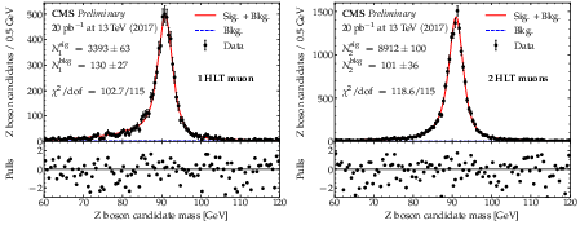
png pdf |
Figure 1:
The upper panels show the reconstructed invariant mass distributions of Z boson candidates for 20 pb$^{-1}$ of data for events where one (left) or two (right) muons pass the single muon trigger selection. The blue curve shows the fitted background contribution, while the red curve illustrates the modeled signal plus background contribution. The numbers of signal and background candidates are given by $ N_i^{\mathrm{sig}}=N_i - N_i^{\mathrm{bkg}} $ and $ N_i^{\mathrm{bkg}} $ respectively. The error bars indicate the statistical uncertainties. The lower panels contain the pulls of the distributions, defined as the difference between the data and the fit model in each bin, divided by the statistical uncertainty estimated from the expected number of entries given by the model. |
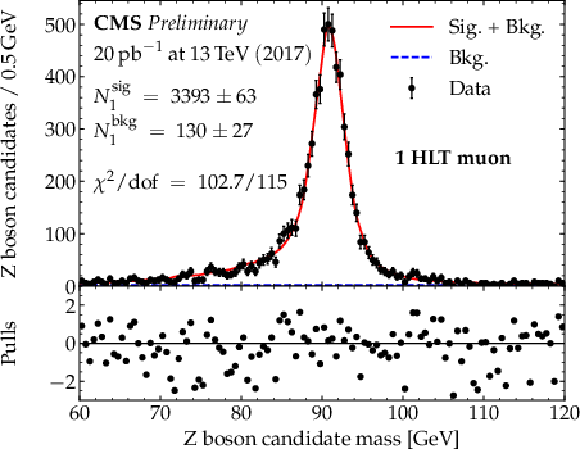
png pdf |
Figure 1-a:
The upper panels show the reconstructed invariant mass distributions of Z boson candidates for 20 pb$^{-1}$ of data for events where one (left) or two (right) muons pass the single muon trigger selection. The blue curve shows the fitted background contribution, while the red curve illustrates the modeled signal plus background contribution. The numbers of signal and background candidates are given by $ N_i^{\mathrm{sig}}=N_i - N_i^{\mathrm{bkg}} $ and $ N_i^{\mathrm{bkg}} $ respectively. The error bars indicate the statistical uncertainties. The lower panels contain the pulls of the distributions, defined as the difference between the data and the fit model in each bin, divided by the statistical uncertainty estimated from the expected number of entries given by the model. |
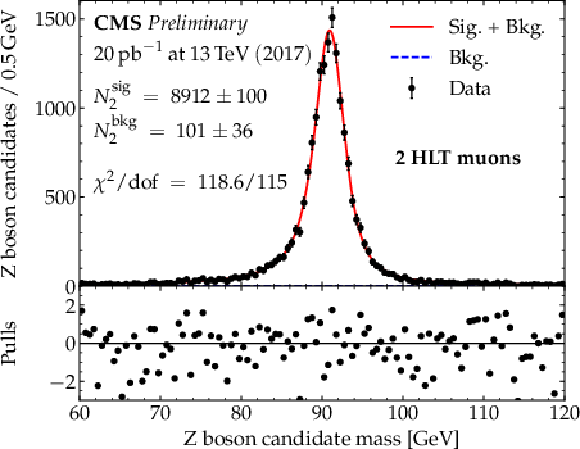
png pdf |
Figure 1-b:
The upper panels show the reconstructed invariant mass distributions of Z boson candidates for 20 pb$^{-1}$ of data for events where one (left) or two (right) muons pass the single muon trigger selection. The blue curve shows the fitted background contribution, while the red curve illustrates the modeled signal plus background contribution. The numbers of signal and background candidates are given by $ N_i^{\mathrm{sig}}=N_i - N_i^{\mathrm{bkg}} $ and $ N_i^{\mathrm{bkg}} $ respectively. The error bars indicate the statistical uncertainties. The lower panels contain the pulls of the distributions, defined as the difference between the data and the fit model in each bin, divided by the statistical uncertainty estimated from the expected number of entries given by the model. |
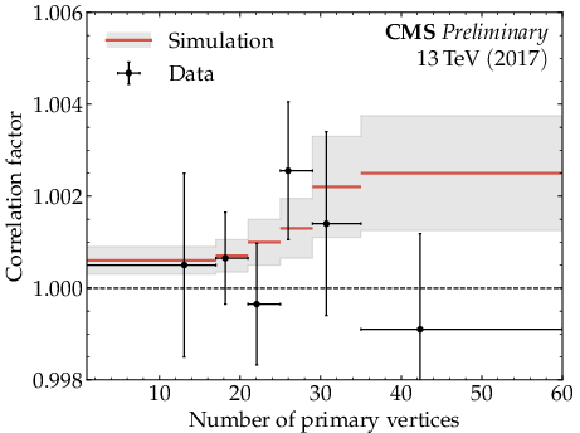
png pdf |
Figure 2:
Correction factor $ C_{\mathrm{HLT}} $ for the correlation between the measured muon trigger efficiencies of the two muons as a function of the number of reconstructed primary vertices, $ N_\mathrm{PV} $, in the simulation (line) and the data (points). The data points are drawn at the mean value of $ N_\mathrm{PV} $ in each bin of the measurement. The horizontal error bars on the points show the bin width, and the vertical error bars show the statistical uncertainty. The gray band indicates 50% of the correction. |

png pdf |
Figure 3:
Left: the Z boson rate, corrected for efficiency, compared to the reference luminosity measurement, in LHC Fill 6255, recorded on 29 September 2017. Each bin corresponds to about 20 pb$^{-1}$, as determined by the reference measurement. For shape comparison, the Z boson rate is normalized to the reference integrated luminosity. The panel at the bottom shows the ratio of the two measurements. Right: the measured single-muon efficiencies as a function of time, in the same LHC Fill 6255. |
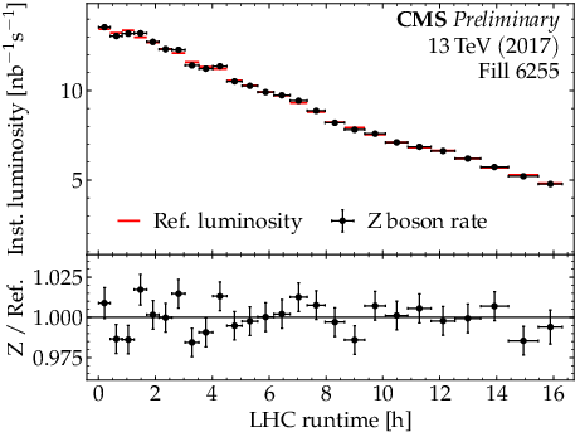
png pdf |
Figure 3-a:
Left: the Z boson rate, corrected for efficiency, compared to the reference luminosity measurement, in LHC Fill 6255, recorded on 29 September 2017. Each bin corresponds to about 20 pb$^{-1}$, as determined by the reference measurement. For shape comparison, the Z boson rate is normalized to the reference integrated luminosity. The panel at the bottom shows the ratio of the two measurements. Right: the measured single-muon efficiencies as a function of time, in the same LHC Fill 6255. |
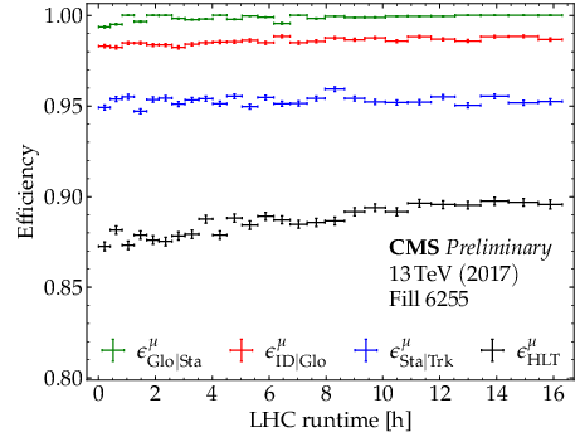
png pdf |
Figure 3-b:
Left: the Z boson rate, corrected for efficiency, compared to the reference luminosity measurement, in LHC Fill 6255, recorded on 29 September 2017. Each bin corresponds to about 20 pb$^{-1}$, as determined by the reference measurement. For shape comparison, the Z boson rate is normalized to the reference integrated luminosity. The panel at the bottom shows the ratio of the two measurements. Right: the measured single-muon efficiencies as a function of time, in the same LHC Fill 6255. |

png pdf |
Figure 4:
Fiducial Z cross section as a function of the instantaneous recorded luminosity, normalized to the average measured cross section. In each point, multiple measurements of the delivered Z rates are combined, the error bars correspond to the statistical uncertainties of the Z rates. The leftmost point, highlighted in red, corresponds to the $ \mathrm{lowPU} $ data. The result of a fit to a linear function is shown as a red line and the uncertainties are covered by the gray band. |

png pdf |
Figure 5:
Each entry of the histogram represents the measurement of the luminosity from Z bosons in one interval of 20 pb$^{-1}$ of the $ \mathrm{highPU} $ data, divided by the integrated luminosity of the reference luminometer in the same interval. The first and last bins include the underflow and overflow contributions. For comparison, a Gaussian distribution with mean and standard deviation of the histogram is shown in red. |
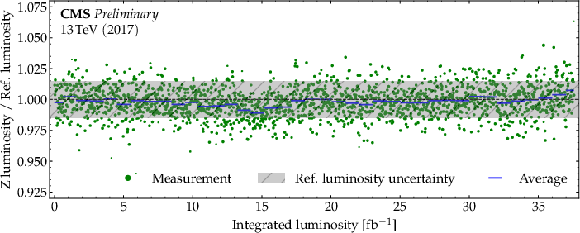
png pdf |
Figure 6:
The luminosity as measured from Z bosons divided by the reference luminosity as a function of the integrated luminosity for the 2017 $ \mathrm{highPU} $ data. Each green point represents the luminosity values measured in one luminosity slice for the measurement of the Z reconstruction efficiency. The size of the point reflects the reference luminosity contained in each measurement. The blue lines show the averages of 50 consecutive measurements, each containing about 1 fb$ ^{-1} $ of data. The gray band has a width of 1.5%, corresponding to the uncertainty in the ratio of reference luminosities [31]. |
| Tables | |
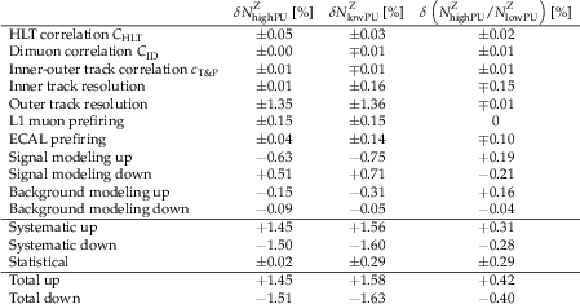
png pdf |
Table 1:
Summary of the uncertainties in the number of delivered Z bosons in the 2017 $ \mathrm{highPU} $ and $ \mathrm{lowPU} $ data, and their ratio. The symbol $ \delta $ denotes the relative uncertainty, i.e.,, $ \delta x = \Delta x / x $. |

png pdf |
Table 2:
Summary of cross checks performed by varying the length of the luminosity interval, the bin width of the $ m_{\mu\mu} $ histograms, and the range of the fit. As in Table 1, the resulting variations of the number of Z bosons in the 2017 $ \mathrm{highPU} $ and $ \mathrm{lowPU} $ data, and their ratio, are shown. The $ \delta $ denotes the relative variations, i.e.,, $ \delta x = \Delta x / x $. |
| Summary |
| The precision measurement of the Z boson production rate provides an alternative and complementary method to transfer integrated luminosity measurements between data sets. This study makes use of events with Z boson candidates decaying into a pair of muons. The data were recorded with the CMS experiment at the CERN LHC in 2017, at a $ {\mathrm{p}\mathrm{p}} $ center-of-mass energy of 13 TeV. The integrated luminosity of the largest data sample recorded in 2017 is obtained from that of a data set recorded at low pileup using the ratio of the efficiency-corrected numbers of Z bosons counted in the two data sets. The full set of efficiencies and correlation factors for the triggering, reconstruction, and selection is determined in intervals of 20 pb$^{-1}$, in situ, from the data. Monte Carlo simulations are only used to describe the shape of the resonant Z boson signal and for the study of possible biases of the method. A full quantitative study of the systematic uncertainties and their dependencies on pileup is performed for the first time. In the luminosity ratio, the systematic uncertainties cancel almost completely, with the exception of the pileup-dependent effects. The resulting uncertainty on the ratio is 0.4%. With its high precision, and providing in situ calibration options, Z boson counting is competitive with, and independent from, conventional methods for the extrapolation and integration of luminosity determined in van-der-Meer scan data. In the future, it can also be used to improve the systematic uncertainty in analysis that combine the integrated luminosities measured in different years. |
| References | ||||
| 1 | CMS Collaboration | Measurement of the inclusive W and Z production cross sections in $ {\mathrm{p}\mathrm{p}} $ collisions at $ \sqrt{s}= $ 7 TeV | JHEP 10 (2011) 132 | CMS-EWK-10-005 1107.4789 |
| 2 | CMS Collaboration | Measurement of the differential Drell--Yan cross section in proton-proton collisions at $ \sqrt{s}= $ 13 TeV | JHEP 12 (2019) 059 | CMS-SMP-17-001 1812.10529 |
| 3 | CMS Collaboration | Measurements of differential Z boson production cross sections in proton-proton collisions at $ \sqrt{s}= $ 13 TeV | JHEP 12 (2019) 061 | CMS-SMP-17-010 1909.04133 |
| 4 | CMS Collaboration | Measurement of the mass dependence of the transverse momentum of lepton pairs in Drell--Yan production in proton-proton collisions at $ \sqrt{s}= $ 13 TeV | Submitted to Eur. Phys. J. C, 2022 | CMS-SMP-20-003 2205.04897 |
| 5 | ATLAS Collaboration | Measurement of $ \mathrm{W}^{\pm} $ and Z boson production cross sections in $ {\mathrm{p}\mathrm{p}} $ collisions at $ \sqrt{s}= $ 13 TeV with the ATLAS detector | PLB 759 (2016) 601 | 1603.09222 |
| 6 | Y. Li and F. Petriello | Combining QCD and electroweak corrections to dilepton production in FEWZ | PRD 86 (2012) 094034 | 1208.5967 |
| 7 | P. F. Monni et al. | MiNNLO$ _{PS} $: a new method to match NNLO QCD to parton showers | JHEP 05 (2020) 143 | 1908.06987 |
| 8 | C. Duhr and B. Mistlberger | Lepton-pair production at hadron colliders at N$ ^{3} $LO in QCD | JHEP 03 (2022) 116 | 2111.10379 |
| 9 | S. Alekhin, J. Blümlein, S. Moch, and R. Placakyte | Parton distribution functions, $ \alpha_s $, and heavy-quark masses for LHC Run II | PRD 96 (2017) 014011 | 1701.05838 |
| 10 | NNPDF Collaboration | Parton distributions from high-precision collider data | EPJC 77 (2017) 663 | 1706.00428 |
| 11 | S. Dulat et al. | New parton distribution functions from a global analysis of quantum chromodynamics | PRD 93 (2016) 033006 | 1506.07443 |
| 12 | L. A. Harland-Lang, A. D. Martin, P. Motylinski, and R. S. Thorne | Parton distributions in the LHC era: MMHT 2014 PDFs | EPJC 75 (2015) 204 | 1412.3989 |
| 13 | CMS Collaboration | Search for invisible decays of a Higgs boson produced through vector boson fusion in proton-proton collisions at $ \sqrt{s}= $ 13 TeV | PLB 793 (2019) 520 | CMS-HIG-17-023 1809.05937 |
| 14 | Particle Data Group , R. L. Workman et al. | Review of particle physics | Prog. Theor. Exp. Phys. 2022 (2022) 083C01 | |
| 15 | CMS Collaboration | Electron and photon reconstruction and identification with the CMS experiment at the CERN LHC | JINST 16 (2021) P05014 | CMS-EGM-17-001 2012.06888 |
| 16 | CMS Collaboration | Performance of the CMS muon detector and muon reconstruction with proton-proton collisions at $ \sqrt{s}= $ 13 TeV | JINST 13 (2018) P06015 | CMS-MUO-16-001 1804.04528 |
| 17 | ATLAS Collaboration | Muon reconstruction performance of the ATLAS detector in proton-proton collision data at $ \sqrt{s}= $ 13 TeV | EPJC 76 (2016) 292 | 1603.05598 |
| 18 | M. Dittmar, F. Pauss, and D. Zurcher | Towards a precise parton luminosity determination at the CERN LHC | PRD 56 (1997) 7284 | hep-ex/9705004 |
| 19 | C. Schwick and B. Petersen | LPC's view on Run 2' | in Proceedings, 9th Evian Workshop on LHC beam operation: Evian Les Bains, France, CERN-ACC-2019-059 January 3 (2019) 27 |
|
| 20 | ATLAS Collaboration | Luminosity determination using $ {\mathrm{Z}\to \ell \ell} $ events at $ \sqrt{s} = $ 13 TeV with the ATLAS detector | ATLAS PUB Note ATL-DAPR-PUB-2021-001 | |
| 21 | ATLAS Collaboration | Luminosity determination in $ {\mathrm{p}\mathrm{p}} $ collisions at $ \sqrt{s}= $ 13 TeV using the ATLAS detector at the LHC | Submitted to EPJC, 2022 | 2212.09379 |
| 22 | R. Bonciani et al. | Mixed strong-electroweak corrections to the Drell--Yan process | PRL 128 (2022) | 2106.11953 |
| 23 | M. Delto, M. Jaquier, K. Melnikov, and R. Röntsch | Mixed QCD$ \otimes $QED corrections to on-shell $ Z $ boson production at the LHC | JHEP 01 (2020) 043 | 1909.08428 |
| 24 | S. van der Meer | Calibration of the effective beam height in the ISR | ISR Report CERN-ISR-PO-68-31, 1968 | |
| 25 | P. Grafström and W. Kozanecki | Luminosity determination at proton colliders | Prog. Part. Nucl. Phys. 81 (2015) 97 | |
| 26 | ATLAS Collaboration | Luminosity determination in $ {\mathrm{p}\mathrm{p}} $ collisions at $ \sqrt{s}= $ 8 TeV using the ATLAS detector at the LHC | EPJC 76 (2016) 653 | 1608.03953 |
| 27 | CMS Collaboration | Precision luminosity measurement in proton-proton collisions at $ \sqrt{s}= $ 13 TeV in 2015 and 2016 at CMS | EPJC 81 (2021) 800 | CMS-LUM-17-003 2104.01927 |
| 28 | CMS Collaboration | Pileup mitigation at CMS in 13 TeV data | JINST 15 (2020) P09018 | CMS-JME-18-001 2003.00503 |
| 29 | A. Dainese et al. | Report on the physics at the HL-LHC, and perspectives for the HE-LHC | CERN Report CERN-2019-007, 2019 link |
|
| 30 | J. Salfeld-Nebgen and D. Marlow | Data-driven precision luminosity measurements with Z bosons at the LHC and HL-LHC | JINST 13 (2018) P12016 | 1806.02184 |
| 31 | CMS Collaboration | CMS luminosity measurement for the 2017 data-taking period at $ \sqrt{s}= $ 13 TeV | CMS Physics Analysis Summary, 2018 CMS-PAS-LUM-17-004 |
CMS-PAS-LUM-17-004 |
| 32 | CMS Collaboration | The CMS experiment at the CERN LHC | JINST 3 (2008) S08004 | |
| 33 | CMS Collaboration | Description and performance of track and primary-vertex reconstruction with the CMS tracker | JINST 9 (2014) P10009 | CMS-TRK-11-001 1405.6569 |
| 34 | CMS Tracker Group Collaboration | The CMS Phase-1 pixel detector upgrade | JINST 16 (2021) P02027 | 2012.14304 |
| 35 | CMS Collaboration | Particle-flow reconstruction and global event description with the CMS detector | JINST 12 (2017) P10003 | CMS-PRF-14-001 1706.04965 |
| 36 | M. Cacciari, G. P. Salam, and G. Soyez | The anti-$ k_{\mathrm{T}} $ jet clustering algorithm | JHEP 04 (2008) 063 | 0802.1189 |
| 37 | M. Cacciari, G. P. Salam, and G. Soyez | FASTJET user manual | EPJC 72 (2012) 1896 | 1111.6097 |
| 38 | CMS Collaboration | Performance of missing transverse momentum reconstruction in proton-proton collisions at $ \sqrt{s} = $ 13 TeV using the CMS detector | JINST 14 (2019) P07004 | CMS-JME-17-001 1903.06078 |
| 39 | CMS Collaboration | Technical proposal for the Phase-II upgrade of the Compact Muon Solenoid | CMS Technical Proposal CERN-LHCC-2015-010, 2015 CDS |
|
| 40 | CMS Collaboration | Performance of the CMS Level-1 trigger in proton-proton collisions at $ \sqrt{s}= $ 13 TeV | JINST 15 (2020) P10017 | CMS-TRG-17-001 2006.10165 |
| 41 | CMS Collaboration | The CMS trigger system | JINST 12 (2017) P01020 | CMS-TRG-12-001 1609.02366 |
| 42 | CMS BRIL Collaboration | The Pixel Luminosity Telescope: A detector for luminosity measurement at CMS using silicon pixel sensors | Accepted by EPJC, 2022 | 2206.08870 |
| 43 | M. Guthoff | The new fast beam condition monitor using poly-crystalline diamond sensors for luminosity measurement at CMS | CMS Collaboration, in Proceedings, 14th Pisa Meeting on Advanced Detectors: Frontier Detectors for Frontier Physics (Pisameet): La Biodola-Isola d'Elba, Italy, 2019 NIM A 936 (2019) 717 |
|
| 44 | J. Alwall et al. | The automated computation of tree-level and next-to-leading order differential cross sections, and their matching to parton shower simulations | JHEP 07 (2014) 079 | 1405.0301 |
| 45 | T. Sjöstrand et al. | An introduction to PYTHIA 8.2 | Comput. Phys. Commun. 191 (2015) 159 | 1410.3012 |
| 46 | CMS Collaboration | Extraction and validation of a new set of CMS PYTHIA 8 tunes from underlying-event measurements | EPJC 80 (2020) 4 | CMS-GEN-17-001 1903.12179 |
| 47 | GEANT4 Collaboration | GEANT 4---a simulation toolkit | NIM A 506 (2003) 250 | |
| 48 | CMS Collaboration | Performance of the CMS muon trigger system in proton-proton collisions at $ \sqrt{s}= $ 13 TeV | JINST 16 (2021) P07001 | CMS-MUO-19-001 2102.04790 |
| 49 | M. J. Oreglia | A study of the reactions $ \psi^\prime \to \gamma \gamma \psi $ | PhD thesis, Stanford University, SLAC-R-236, 1980 link |
|
| 50 | S. Das | A simple alternative to the Crystal Ball function | 1603.08591 | |

|
Compact Muon Solenoid LHC, CERN |

|

|

|

|

|

|